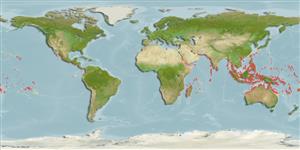Common names from other countries
Environment: milieu / climate zone / depth range / distribution range
Ecología
marino; agua dulce; salobre demersal; anfidromo (Ref. 51243); rango de profundidad 0 - 5 m (Ref. 86942). Tropical; 25°C - ? (Ref. 2059); 45°N - 27°S
Indo-West Pacific: throughout the Indo-Pacific, from east African coasts to Philippines, Melanesia and Polynesia (Ref. 6802); east African coast south to Transkei (Ref. 52193).
Tamaño / Peso / Age
Maturity: Lm ? range ? - ? cm
Max length : 26.0 cm TL macho / no sexado; (Ref. 5493)
Espinas dorsales (total): 7; Radios blandos dorsales (total): 8; Espinas anales 1; Radios blandos anales: 8. Diagnosis: Longitudinal line scales 57-68; preopercular spine present; 8-10 gillrakers on lower part of first branchial arch (Ref. 5493, 79840). Dark brown to black in color; horizontal lines on body; young with spotted fins (Ref. 5493).
Adults inhabit lagoons, estuaries and freshwater (Ref. 6028, 48637, 79840). They occur in the lower reaches of freshwater streams, usually on mud bottoms (Ref. 44894). Juveniles are found mainly among mangrove roots in the more saline areas of lagoons and estuaries (Ref. 6028, 79840). Carnivorous (Ref. 79840). Marketed fresh (Ref. 12693).
Life cycle and mating behavior
Madurez | Reproducción | Puesta | Huevos | Fecundidad | Larva
Spawns eggs on submerged plants with small leaves. Female tends and fans the eggs until hatching and loosely guards the fry for a few days thereafter.
Maugé, L.A., 1986. Eleotridae. p. 389-398. In J. Daget, J.-P. Gosse and D.F.E. Thys van den Audenaerde (eds.) Check-list of the freshwater fishes of Africa (CLOFFA). ISNB, Brussels; MARC, Tervuren; and ORSTOM, Paris. Vol. 2. (Ref. 6802)
IUCN Red List Status (Ref. 130435)
CITES (Ref. 128078)
Not Evaluated
Threat to humans
Harmless
Human uses
Pesquerías: escaso valor comercial; Acuario: Comercial
Herramientas
Special reports
Download XML
Fuentes de Internet
Estimates based on models
Preferred temperature (Ref.
115969): 25.4 - 29.3, mean 28.5 (based on 3082 cells).
Phylogenetic diversity index (Ref.
82804): PD
50 = 0.5000 [Uniqueness, from 0.5 = low to 2.0 = high].
Nivel trófico (Ref.
69278): 3.8 ±0.3 se; based on diet studies.
Resiliencia (Ref.
120179): Medio, población duplicada en un tiempo mínimo de 1.4-4.4 años (Preliminary K or Fecundity.).
Fishing Vulnerability (Ref.
59153): Low vulnerability (16 of 100).
